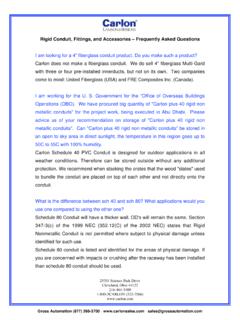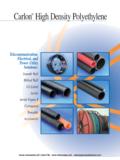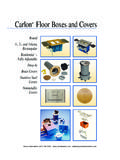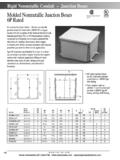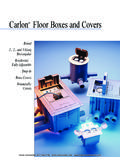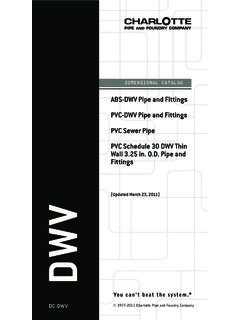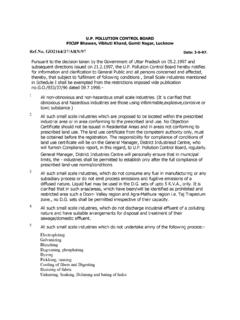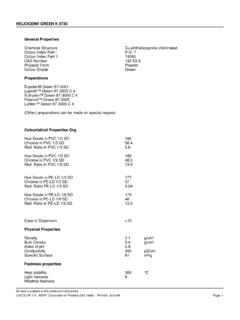Transcription of MATERIAL SAFETY DATA SHEET SECTION 1 PRODUCT AND …
1 MSDS No: CAR070E5 Issue Date: 30 Sept. 2005 Page: 1 of 5 MATERIAL SAFETY data SHEET SECTION 1 PRODUCT AND company identification Trade Name: CARLON STANDARD GRAY PVC CEMENT PRODUCT Numbers: VC9924-24 PRODUCT Use: Cement for PVC Plastic Pipe Formula: PVC Resin in Solvent Solution Synonyms: PVC Plastic Pipe Cement Firm Name & CARLON ELECTRICAL PRODUCTS c/o OATEY CO.
2 4700 West 160th Street Mailing Address: Box 35906 Cleveland, Ohio 44135, Phone Number: (216) 267-7100 or (800) 321-9532 Emergency Phone For Emergency First Aid call 1-303-623-5716 COLLECT. For Numbers: chemical transportation emergencies ONLY, call Chemtrec at 1-800-424-9300. Outside the 1-703-527-3887. Prepared By: Corporate Director SAFETY and Environmental Compliance Preparation Date: September 30, 2005 SECTION 2 COMPOSITION/INFORMATION ON INGREDIENTS INGREDIENTS: %wt/wt: CAS NUMBER: ACGIH TLV TWA: OSHA PEL TWA: OTHER:Methyl Ethyl Ketone 10 - 60% 78-93-3 200 ppm 200 ppm None 300 ppm STEL Tetrahydrofuran 20 - 50% 109-99-9 50 ppm(skin) 200 ppm 25 ppm (Mfg) 100 ppm STEL Acetone 0 - 20% 67-64-1 500 ppm 1000 ppm None 750 ppm STEL PVC Resin 10 - 18% 9002-86-2 10 mg/m3 15 mg/m3 None (Non-hazardous) Cyclohexanone 2 - 15% 108-94-1 20 ppm(skin) 50 ppm None 50 ppm STEL O SHA Hazard Classification.
3 Flammable, irritant, organ effects SECTION 3 HAZARDS identification Emergency Overview: Clear liquid with an ether-like odor. Extremely flammable liquid and vapor. Vapors may cause flash fire. May cause eye and skin irritation. Inhalation of vapors or mist may cause respiratory irritation and central nervous system effects. Swallowing may cause irritation, nausea, vomiting, diarrhea and kidney or liver disorders. Aspiration hazard. May be fatal if swallowed. Symptoms may be delayed. SECTION 4 FIRST AID MEASURES CALL 1-303-623-5716 COLLECT Skin: Remove contaminated clothing immediately.
4 Wash all exposed areas with soap and water. Get medical attention if irritation develops. Remove dried cement with Oatey Plumber's Hand Cleaner or baby oil. Eyes: If MATERIAL gets into eyes or if fumes cause irritation, immediately flush eyes with plenty of water until chemical is removed. If irritation persists, get medical attention immediately. Inhalation: If symptoms of exposure develop, remove to fresh air. If breathing becomes difficult, administer oxygen. Administer artificial has stopped. Seek immediate medical attention. respiration if breathingIngestion: DO NOT INDUCE VOMITING.
5 Rinse mouth with water. Never give anything by mouth to a person who is unconscious or drowsy. Get immediate medical attention by calling a Poison Control Center, or hospital emergency room. If medical advice cannot be obtained, then take the person and PRODUCT to the nearest medical emergency treatment center or hospital. Gross Automation (877) 268-3700 MSDS No: CAR070E5 Issue Date: 30 Sept. 2005 Page: 2 of 5 SECTION 5 FIRE FIGHTING MEASURES Flashpoint / Method: 0 - 5 Degrees F.
6 (-18 - -15 Degrees C) / PMCC Flammability: LEL = % Volume, UEL = % Volume Extinguishing Use dry chemical, CO2, or foam to extinguish fire. Cool fire Media: exposed container with water. Water may be ineffective as an extinguishing agent. Special Fire Firefighters should wear positive pressure self-contained Fighting breathing apparatus and full protective clothing for fires in Procedure: areas where chemicals are used or stored Unusual Fire and Extremely flammable liquid. Keep away from heat and all Explosion sources of ignition including sparks, flames, lighted Hazards: cigarettes and pilot lights.
7 Containers may rupture or explode in the heat of a fire. Vapors are heavier than air and may travel to a remote ignition source and flash back. This PRODUCT contains tetrahydrofuran that may form explosive organic peroxide when exposed to air or light or with age. Hazardous Combustion will produce toxic and irritating vapors including Decomposition carbon monoxide, carbon dioxide and hydrogen chloride. Products: SECTION 6 ACCIDENTAL RELEASE MEASURES Spill or Remove all sources of ignition and ventilate area. Stop leak if it Leak can be done without risk.
8 Personnel cleaning up the spill should Procedures: wear appropriate personal protective equipment, including respirators if vapor concentrations are high. Soak up spill with an inert absorbent such as sand, earth or other non-combusting MATERIAL . Put absorbent MATERIAL in covered, labeled metal containers. Prevent liquid from entering watercourses, sewers and natural waterways. Report releases to authorities as required. See SECTION 13 for disposal information. SECTION 7 HANDLING AND STORAGE Handling: Avoid contact with eyes, skin and clothing.
9 Avoid breathing vapors or mists. Use with adequate ventilation (equivalent to outdoors). Wash thoroughly after handling. Do not eat, drink or smoke in the work area. Keep PRODUCT away from heat, sparks, flames and all other sources of ignition. No smoking in storage or use areas. Keep containers closed when not in use. Storage: Store in a cool, dry, well-ventilated area away from incompatible materials. Keep containers closed when not in use. Other: "Empty" containers retain PRODUCT residue and can be hazardous. Follow all MSDS precautions in handling empty containers.
10 Do not cut or weld on or near empty or full containers. SECTION 8 EXPOSURE CONTROLS/PERSONAL PROTECTION Ventilation: Open doors & windows. Provide ventilation capable of maintaining emissions at the point of use below recommended exposure limits. If used in enclosed area, use exhaust fans. Exhaust fans should be explosion-proof or set up in a way that flammable concentrations of solvent vapors are not exposed to electrical fixtures or hot surfaces. Respiratory For operations where the exposure limit may be exceeded, a NIOSH Protection: approved organic vapor respirator or supplied air respirator is recommended.
